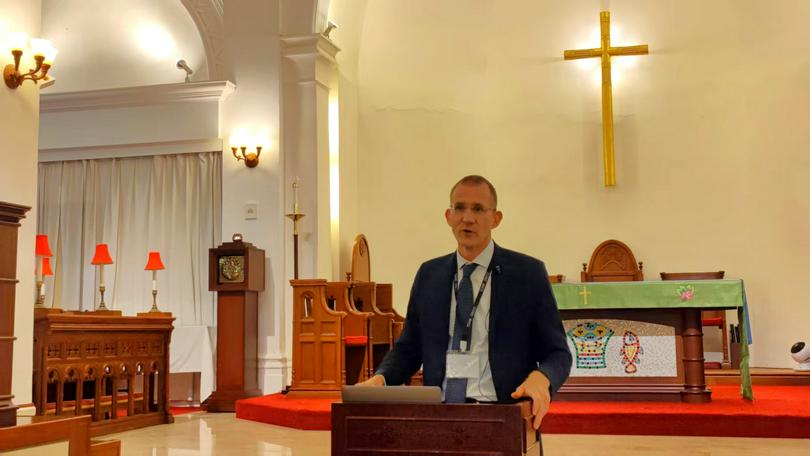On September 13, 2025, in commemoration of the 1700th anniversary of the Council of Nicaea, a conference titled "The Unfinished Business of Nicaea" was held at the HKSKH All Saints' Cathedral.
The event, moderated by Prof. Tobias Brandner of the Divinity School of Chung Chi College, CUHK, featured a keynote lecture by Prof. Volker Henning Drecoll, the distinguished Chair of Ancient Church History from the University of Tübingen. Prof. Drecoll presented a compelling analysis of the Nicene Creed's evolution, challenging long-held narratives about its origins.
Prof. Drecoll began by tracing the roots of the debate to the third century, long before the Council of Nicaea. He identified the Synod of Antioch in 268 as a crucial starting point. This synod grappled with the teachings of Paul of Samosata, which brought to the forefront the central conflict of early Christology: the relationship between the eternal Logos (the Word, or Son) and God the Father.
Two fundamental and conflicting perspectives emerged from this period. One view held that the Logos was an essential and eternal part of the Father, inseparable like the sun and its light. The other perspective argued that the Father, through a voluntary act of will, chose to generate the Logos as the supreme agent for creation, meaning the Son's existence was dependent on the Father's decision. This fundamental tension between an "essential" versus a "voluntary" relationship framed all subsequent debates.
The lecture then moved to the Council of Nicaea in 325 AD, convened by Emperor Constantine. Prof. Drecoll described the resulting creed not as a definitive victory for one side, but as a carefully negotiated compromise. He emphasized that, contrary to popular belief, the figure of Arius and a clearly defined "Arianism" were not the central focus of the council itself. The discussions were broader, dealing with the long-standing theological problems inherited from the previous century.
A central and vividly illustrated point of the lecture was that "Arianism," as a coherent and monolithic heresy, was largely a later invention, masterfully crafted by Athanasius of Alexandria in the decades following the council.
Prof. Drecoll explained that Athanasius, facing exile and intense political opposition, needed a powerful rhetorical tool to rally support. He effectively reframed a complex, multi-sided theological landscape into a simple, binary conflict of "orthodoxy versus heresy."
Athanasius did this by taking Arius, one theological figure among many, and elevating him to the status of an archetypal villain. He pinned specific, condemned phrases from the Nicene Creed's anathemas—such as the Son being "created out of nothing"—directly onto Arius and, by extension, all of his own opponents. This strategy created a clear enemy, "Arianism," allowing Athanasius to label anyone who disagreed with him as a follower of this condemned heretic, a tactic that proved brilliantly successful in the theological and political wars of the fourth century.
The debates continued to evolve for fifty years after Nicaea, delving into other complex issues such as the nature of Christ's human soul. This further demonstrates that the conflict was far more nuanced than a simple dispute with Arius.
Prof. Drecoll also highlighted a significant historical puzzle concerning the Nicene-Constantinopolitan Creed, the version widely used today. This creed is first officially documented at the Council of Chalcedon in 451, a full 70 years after the Council of Constantinople in 381, where it was supposedly finalized. One leading scholarly theory suggests it may have been an unpublished document from 381, intended for peace talks that failed, only to be rediscovered and officially adopted decades later at Chalcedon.
In response, The Very Revd Samson Fan, Dean of HKSKH All Saints' Cathedral, concurred with Prof. Drecoll's historical analysis. His main point was to shift the focus from the creed as a historical document to its function as a living act of worship. He emphasized that the creed's true power is unleashed in the liturgy, where the community stands together to confess its faith. He also drew a parallel to the Jewish Shema, noting that both are acts of communal remembering that shape identity and unite believers across time.
During the following Q&A session, one significant question addressed the "unfinished business" for the church today, particularly for younger generations. Prof. Drecoll responded that this means each generation must actively reinterpret the faith for its own context, engaging critically with tradition rather than being enslaved by it or ignoring it.
Another question touched on the controversial filioque clause ("and the Son"). Prof. Drecoll clarified it was a later Western addition intended to explain the Trinity's inner communion, not to alter the creed's original intent.
Prof. Drecoll concluded by reiterating that the creed is not a static formula but a keystone that sets the boundaries for the ongoing theological task of understanding Christ. The profound questions that fueled its creation, he noted, remain relevant and continue to demand theological reflection today.












